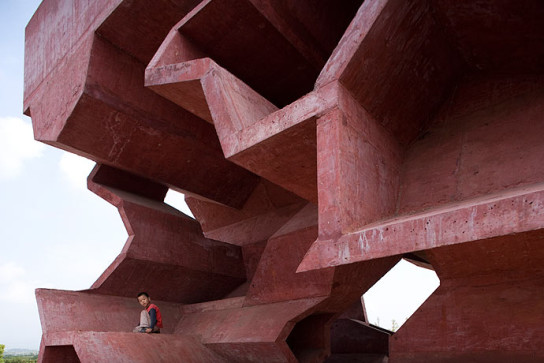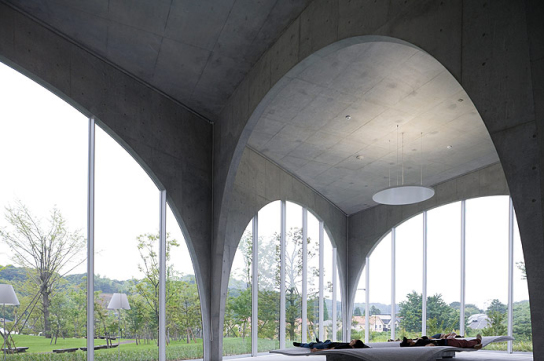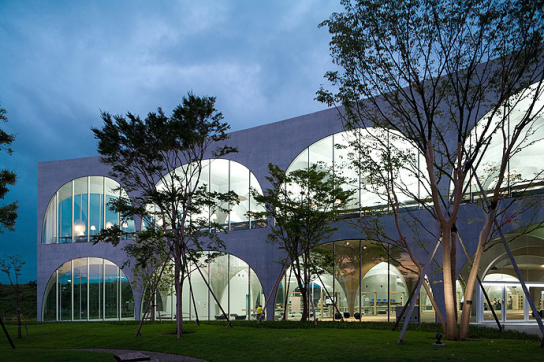
Architect: Architecture Research Unit Location: Paju Book City, Korea Year: 2009 Photographs: Jonathan Lovekin









v








+
Your Custom Text Here

Architect: Architecture Research Unit Location: Paju Book City, Korea Year: 2009 Photographs: Jonathan Lovekin









v








+

Architects: Wang Shu, Amateur Architecture Studio Location: Ningbo, Zhejiang, China Year: 2008 Photographs: Iwan Baan











+

Curated by Ai Weiwei Location: Jinhua, Shanghai , China Year: 2007 Photographs: Iwan Baan
Architects: Till Schweizer, Christ&Gantenbein, Tatiana Bilbao, HHF architects, Liu JiaKun, Wang XingWei, Buchner Bruendler, Chen ShuYu, Wang Shu, Ai Weiwei, Toshuko Mori, Erhard An-He Kinzelbach, Johan de Wachter, Fernando Romero, Herzog&de Meuron, Michael Maltzan, Zhang YongHe
"The idea is that half of it is above ground, and from this particular angle it looks like a normal house with a pitched roof. From the other side, however, you can see that in fact half of it is submerged - in section the building is hexagonal. The pathways in the forecourt are also hexagonal, in fact. The building is a single long slab, cast in reinforced concrete." /Ai Weiwei










































+

History Images by Sze Tsung Leong
The photographs in History Images are of histories, in the form of cities in China, either being destroyed or created at this juncture in time. They are of past histories, in the form of traditional buildings and neighborhoods, urban fabrics, and natural landscapes, in the process of being erased. They are of the absence of histories, in the form of construction sites, built upon an erasure of the past so complete that one would never know a past had ever existed. And they are of the anticipation of future histories, yet to unfold, in the form of newly built cities.





Cities are the largest, most enduring, and most encompassing documents of history, uniquely recording the variations and residues of time. Substantial urban change is generally expected to span over prolonged periods: decades, generations, centuries. The evidence of these changes is usually gradual and cumulative; residues of history are slowly left in built form, giving physical shape to the accretions of time. There are moments in history, however, that accelerate the rate of urban change: warfare, changes of regime, transformations of social structure, economic prosperity. These moments force societies to evaluate their relationship to their own history and their attitude to their future, in turn affecting their relationship to their environments. China presently finds itself in one of these moments, as its recent transformations in politics, society, and economics have triggered changes to its cities to a degree not previously seen in its contemporary history.






As much as China’s cities are presently changing, so has China’s relationship with history. In Imperial China, history was a stable, unchanging reality that gave order and uniformity to society and, in turn, to its urban spaces. After the Communist Revolution, history was seen as an enemy in need of dismantling, as summarized in the popular Cultural Revolution slogan, “Smash the Old World, Build the New World”. Presently in China, history as urban form is seen in contradictory terms: as proof of China’s accomplishments and contributions to civilization, yet more often as an inconvenience to urban modernization. Ironically, China’s current economic revolution is facilitating the physical destruction of history that was called for during the Cultural Revolution. From the resulting emptiness the components of China’s new cities are built out of nothing: luxury apartments, shopping centers, supermarkets, widened roads, tennis courts, office blocks, parking lots.




These photographs are of histories recorded in urban form, all simultaneously occurring, all in the midst of change. They are records of cities in time, in the process of perishing, disappearing, or starting anew: a Ming and Qing Dynasty neighborhood of traditional courtyard houses in Beijing being demolished to make way for luxury housing; a city razed as a result of the construction of the Three Gorges Dam, now the largest dam in the world; a new city built to accommodate the relocation of populations whose former cities will be flooded by the Yangtze River; a traditional district in Chongqing waiting to be destroyed, surrounded by new construction; anonymous construction sites marking the empty moment between the erasure of the past and the arrival of the future. These photographs are of cities caught in the tenuous period after the end of one history and at the beginning of another history.





Text + Photography by Sze Tsung Leong, April 2004
more: http://www.szetsungleong.com
#

Architects: buchner bruendler architekten Location: Basel, Switzerland Year: 2010 Photographs: Ruedi Walti
















Architects: Studio Mumbai Location: Leti, Uttaranchal, India Year : 2007 Photographs: Courtesy of Studio Mumbai













#

Architects: Gerardo Caballero Maite Fernandez Arquitectos
Location:Rosario, Santa Fe Province, Argentina
Year: 2009
Photographs: Gustavo Frittegotto















Architects: Toyo Ito 伊東豊雄建築設計事務所 Location: Hachioji City, Tokyo, Japan Year: 2007 Photographs: Iwan Baan

















![Axnometric [Convertido]](http://static1.squarespace.com/static/59cf7b252994ca305e64d591/59d01981365ffa6997302231/59d01a33365ffa69973036d6/1506810419453/archaic_tamaartuniversitylibrary_toyoito2-544x737.jpg?format=original)




Architect: Valerio Olgiati Location: Zernez, Switzerland Year: 2008 Photographs: Javier Miguel Verme
#